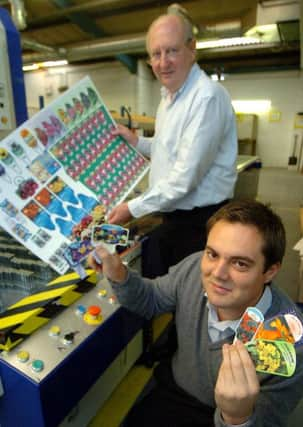Print industry finds its feet again


James Buffoni, commercial director of the Ryedale Group, told The Yorkshire Post that there will always be a demand for print as people like the heuristic element.
He said: “The paperless office was a big thing that was predicted a while ago, it never came true.”
Advertisement
Hide AdAdvertisement
Hide AdRyedale Group has seen seismic shifts in the print sector since Mr Buffoni’s grandfather bought the North Yorkshire-based business in the 1950s. Along with the changes the firm has itself had to adapt and innovate.
In the 1980s John Buffoni, James’ father and managing director of Ryedale Group, was approached by a friend in the horticultural industry. Due to the harsh conditions of greenhouses, traditional labels had a tendency to fade and wither. The Ryedale Group came up with the solution of printing on plastic, to produce more durable plant labels.
At this point the firm entered the horticultural business. John Buffoni said: “For developing print on plastic, we had to develop inks, we had to develop plastic substrates – it was a bit of a black art for a number of years. But we eventually became very competent and we were able to pretty much dominate the UK horticultural market.”
But the seasonal nature of horticulture is a problem for the group. James Buffoni said: “The killer thing about horticulture is that it’s so very seasonal. So this year we will do just over £5m in turnover in horticulture, but we will be doing half of that in February and March.”
Advertisement
Hide AdAdvertisement
Hide AdHe added: “We were in danger of specialising ourselves out of any future.”
Mr Buffoni said that they have to be very flexible as a business as a result of the seasonality. “The demands of all of that really causes us to be very inventive in what we do, so we stopped being a commercial printer in our minds and became specialist innovators,” he added.
This innovation led the Ryedale Group to printed electronics. James Buffoni said: “Instead of having a green silicon chipboard that you’d see in a computer, rather than welding circuits together, we’re talking about printing using a conductive ink.”
The firm used its knowledge of specialist inks in horticulture to come up with an electrically conducting ink but not without its challenges. They tried many different elements before settling on carbon.
Advertisement
Hide AdAdvertisement
Hide AdIn 2011, the group was given a grant to develop printable electronics and after proving the concept with help from Leeds University the firm is looking to continue developing the innovation.
James Buffoni said: “What we’ve found is that print has taken a bit of a knocking but what has happened is your junk mail has been replaced by your junk email and now your emails are under pressure and declining.
“The high end print is starting to come back.”
He admits if you go back in time Print had a much larger slice of the communications pie, but now with the advent of digital, the slice is smaller but no less important.
“Print rather than being the go to medium for everything, it’s going to be the one really that legitimises what you do,” he said.
Advertisement
Hide AdAdvertisement
Hide AdHe added the Ryedale Group now looks at all communications channels, including print, to see how they work best for their customers. Ryedale has a turnover of just over £7m and employs around 85 people, with seasonal staff numbers reaching 125.